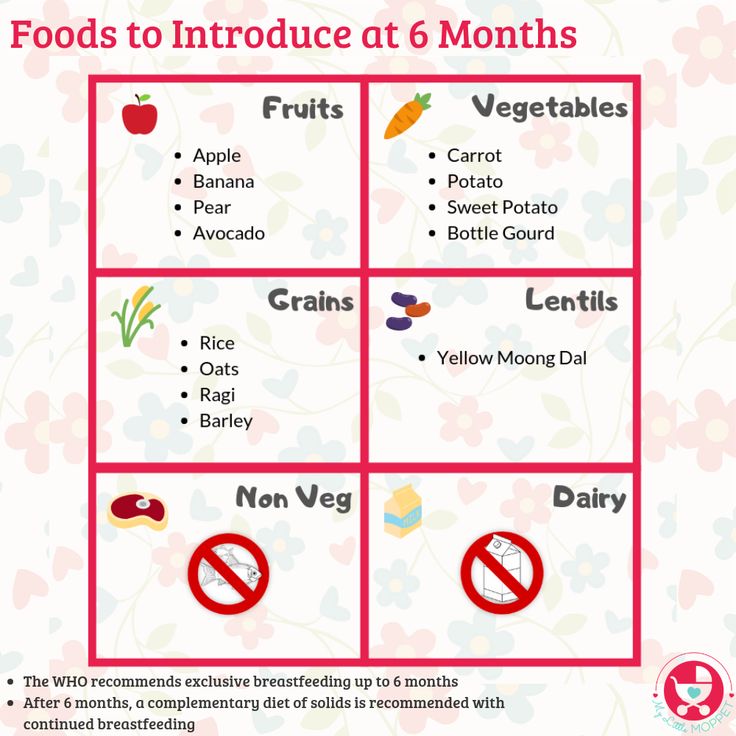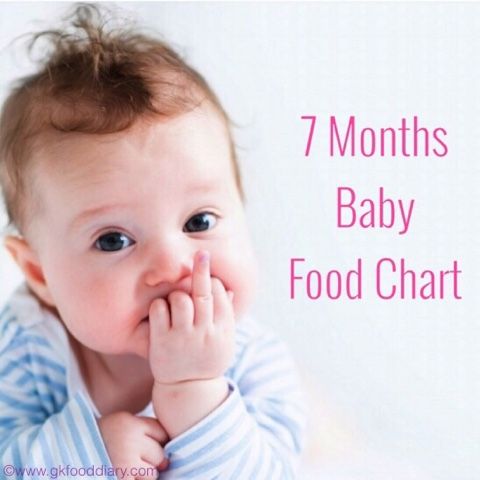Food chart for baby after 6 month
6 months baby food chart with baby food recipes
By Swasthi on August 6, 2022, Comments,
6 months baby food chart with baby food recipes. The best time to start solids for babies is after 6 months. There are many sources suggesting introduction of solids from 3 to 4 months. But an early introduction of solids can lead to more colic, digestive troubles and allergies.
A baby develops digestive enzymes in between 4 to 6 months which are crucial for digestion of foods. It is a good choice to wait until the baby develops these enzymes completely.
A baby typically begins to develop head control from 3 to 4 months and gains strong head to neck muscles by 6 months. A strong head to neck control helps the baby to accept solids well and can easily swallow.
So by 6 months a baby has a better digestive system and a good head control which are needed before the introduction of solids.
Breast milk is the best bet for the overall growth of a baby. It is recommended to exclusively breast feed a baby for the first 6 months.
As an exception, formula milk is an alternate for women who cannot breast feed baby due to professional, personal or medical reasons.
If you have a baby older than 7 months, you can follow this complete
baby food chart for 8 months old and above
How do you know your baby is ready for solids?
1. The baby’s head & neck are stable. This means baby can accept food and swallow.
2. Baby must be able to sit stable with or without support.
3. Shows interest in food when others are eating.
4. Baby must be able to open the mouth when food is offered.
5. Baby is still hungry after breastfeeding or formula feed.
Tips on how to start solids for baby
First consult your pediatrician to confirm if your baby is ready for solids. It is very important to plan well before you introduce any other foods apart from breast milk.
Make your own feeding schedule along with the foods you intend you try and get an approval from your pediatrician.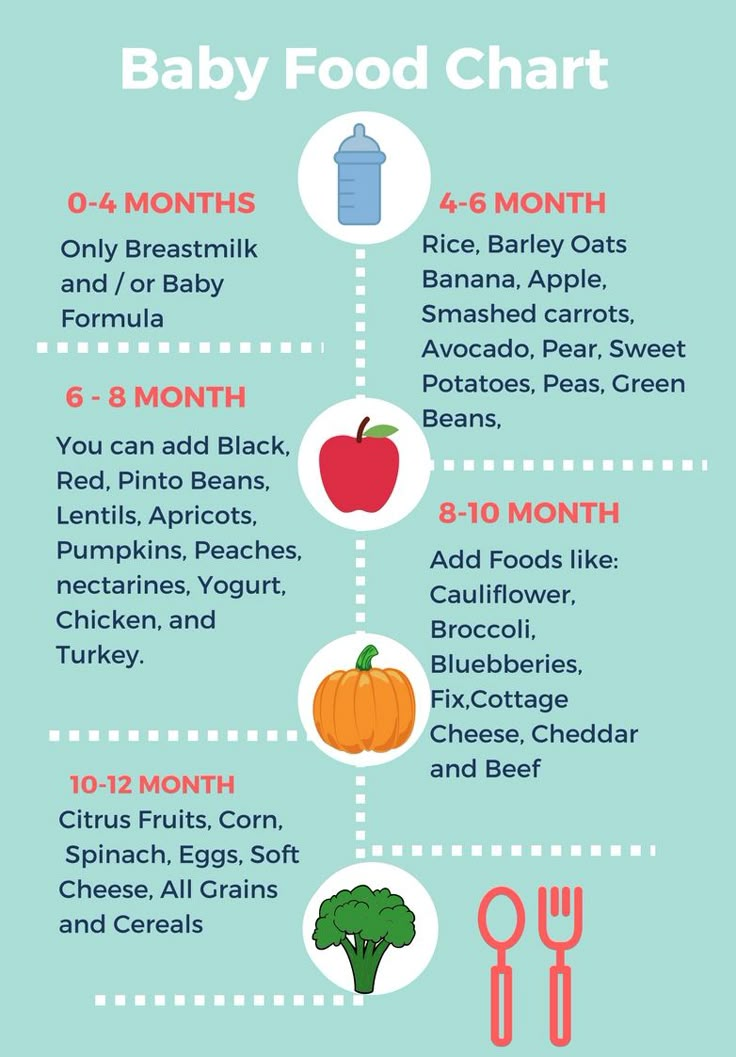 Most clinics and hospitals also provide a diet chart or at least a guide.
Most clinics and hospitals also provide a diet chart or at least a guide.
I have made this from the guidelines I got from the Clinics here in Singapore. I have followed the same for both my babies.
1. Always start with a single food. Either a fruit, vegetable or grain. Avoid a mixture of foods. You can start with mashed fruit first. The presence of digestive enzymes in fruits helps the baby to digest them better.
2. After a week, while you continue feeding fruit, you can start rice water (kanji), after a week clear dal soup or boiled vegetable broth / water.
3. Always follow the 3 day wait rule for every food you introduce. Wait for the results until the 4th day. Please see the doctor immediately if your baby develops rashes, runny nose, watery eyes, colic etc.
4. Introduce new foods to your baby during breakfast or lunch. Avoid trying new foods during the later time of the day as it is easy to get a control over the problems.
5. A 7 month old baby can eat only a tsp of mashed food initially. Slowly by 4 weeks increase the quantity to a tbsp and then more.
Slowly by 4 weeks increase the quantity to a tbsp and then more.
Helpful tips – introducing solids for baby
1. Use stainless steel or glass bowls and cups for preparation of baby foods. Avoid plastic ware even made of any superior material, including virgin plastic or graded as BPA free. Any kind of plastic ware consists of plasticizers that are used to make the containers flexible.
Plasticizers are similar to BPA and are an endocrine disruptor. Even BPA free plastic and virgin plastic ware have chemical plasticizers. Please use google search for more info.
2. Always feed the baby in a calm, quite environment and in a steady place like – on the lap, in a high chair or on the floor.
3. While feeding, refrain the baby from activities like watching a TV show, playing with a hand held gadget like mobile, and tablet or game devices. Some of these emit radiation that is not good for the baby.
4. Meal time has to be a learning for the baby, speaking to your baby about the food – its texture, taste and color helps the baby to develop a liking for the food.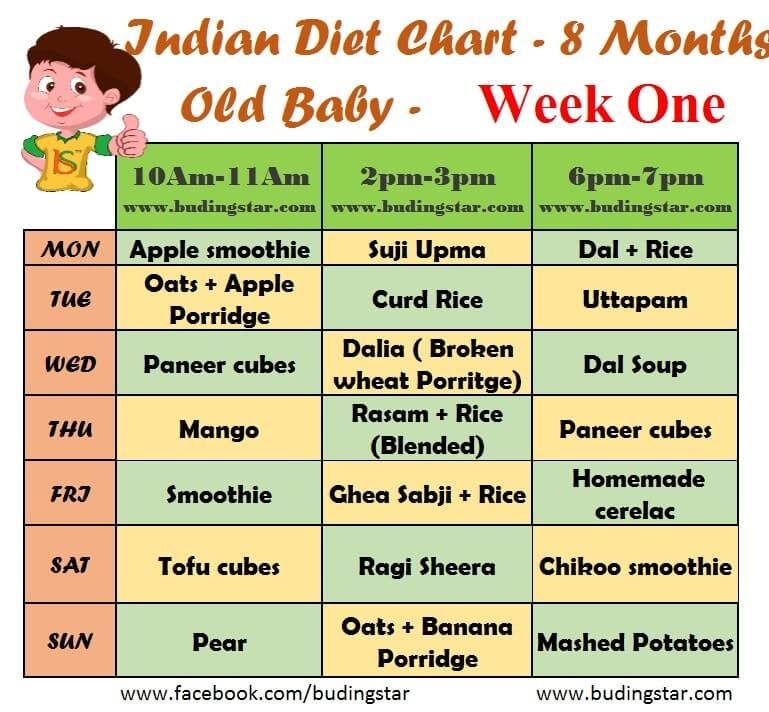 Or narrate a good story to the baby, do not encourage the baby to talk while eating. This may seem to be over disciplined but this is the only way i have found to grow fuss free kids. They will begin to love any food that is served.
Or narrate a good story to the baby, do not encourage the baby to talk while eating. This may seem to be over disciplined but this is the only way i have found to grow fuss free kids. They will begin to love any food that is served.
5. Introduce water from a steel cup or a glass not from a feeding bottle or sipper. A 90 ml cup is best suited. This makes the transition from teat to cup easy when the baby grows up.
6 months baby food chart
To follow this baby chart please ensure your baby has completed 6 months and you have an approval from your pediatrician for the same.
A baby usually consumes milk every 2 to 3 hours. Solids should be served in between the feeds. Use plain boiled and cooled water to puree the fruits if needed. Avoid mixing milk or any other ingredient with fruit.
The combination of fruit and milk products results in indigestion, loss of appetite, no weight gain and accumulation of toxins.
Clear soups can be used to make pureed rice, oats or ragi cereal. Feeding only clear soups regularly is not a good idea as they lack the nutrition that is provided by a semi solid food or milk.
Feeding only clear soups regularly is not a good idea as they lack the nutrition that is provided by a semi solid food or milk.
I have shared a sample baby food chart below which shows the quantities of fruits and vegetables. From the chart (day 13 to day 20), you can replace potato with rice porridge (kanji) or dal soup or ragi porridge.
This is an alternate table which you can follow if your baby is in between 6 and 7 months.
| Breastfeed or formula milk. What ever time your baby wakes up. |
7.30 to 8 am fruit puree |
| One of the following: (only after 1½ to 2 hours of milk). You can use boiled cooled water to thin down the puree. 1. Banana- mash with a fork or run in a blender. 2. Apple- peel,core,steam for about 5 to 6 minutes. Puree in a blender 3. Chickoo (sapota)- mash with a fork and spoon 4.  Pear- peel and core, steam for 5 to 6 minutes Pear- peel and core, steam for 5 to 6 minutes5. Papaya – mash with a fork or blend 6. Ripe avocado – add it to a blender and puree |
11.30 to 12.30 pm |
| After introducing fruits, you can try these. Continue to feed fruits for breakfast. first 1 week – rice cereal 2nd week apple rice or rice cereal with boiled carrot 3rd week ragi porridge Or apple ragi or oats porridge Or apple oats Or clear moong dal soup 4th week – Repeat the foods mentioned above. You can also introduce soupy khichdi. You will have to make it following the same method I mentioned for rice cereal above. |
| Breast feed or formula (only after 1.5 to 2 hours of lunch) |
Baby food recipes for 6 months old along with ingredients and instructions to prepare
These are the quantities i followed for my kids i got from the Health Promotion Board,Singapore. Use any one
Use any one
Quantity of fruits for 6 months to 9 months
½ small apple
½ small pear
½ cup sapota
½ cup papaya
½ medium banana
How many times can the same fruit be given in a week?
Including a variety of fruits will provide different kinds of nutrients to the baby.
Banana – 3 to 4 times
Apple – daily
Chickoo- daily
Pear- 3 to 4 times
Papaya – 4 to 5 times
Avocado- 3 to 4 times or daily
Do read the complete post before you attempt any of these recipes
More tips on preparing Lunch
from 3 rd week – Rice, ragi or oats. Clear dal soup with veggie.
first 7 days (from 3rd week) -Single grain with milk (formula or breast milk). You can also use gluten free or baby oats or ragi to make porridge.
next 7 days – Rice with a single veggie or apple. You can use steamed or boiled carrots.
VEGETABLES to prefer
1. carrots
2. pumpkin
LENTIL/ DAL to prefer
1. moong dal
2. toor dal
toor dal
About Swasthi
I’m Swasthi Shreekanth, the recipe developer, food photographer & food writer behind Swasthi’s Recipes. My aim is to help you cook great Indian food with my time-tested recipes. After 2 decades of experience in practical Indian cooking I started this blog to help people cook better & more often at home. Whether you are a novice or an experienced cook I am sure Swasthi’s Recipes will assist you to enhance your cooking skills.
Follow Swasthi’s Recipes
Sign up to receive awesome Swasthi’s Recipes in your inbox *
Popular Recipes
Featured Recipes
6 Months Baby Food Chart
Start your little one’s journey into solid foods the right way with our 6 months Baby Food Chart! Includes healthy and nutritious Indian recipes too!
Things to Remember before Weaning your Baby
Basic Tips for Feeding your 6 Month Old Baby:
6 Months Baby Food Chart with Indian Recipes
Week 1 – 6 Months Baby Food Chart
Week 2 -6 Months Baby Food Chart
Week 3- 6 Months Baby Food Chart
Week 4- 6 Months Baby Food Chart
How do you know that your baby has an allergy to a particular food?
What to do if your baby is allergic to a particular food?
Buy Healthy Nutritious Baby, Toddler food made by our own Doctor Mom !
So your baby is 6 months old – congratulations, she’s ready to start solid foods! Many Moms eagerly wait for that moment when their little ones start eating new foods. It’s so much fun to watch the expressions on those little faces change as they taste new flavors!
It’s so much fun to watch the expressions on those little faces change as they taste new flavors!
Things to Remember before Weaning your Baby
Be sure that your baby is ready for starting solids by checking her physical developmental milestones. Please remember that at this age, breast milk is still the major part of your baby’s diet. WHO recommends exclusive breastfeeding till 6 months of age, and breast milk to complement solids for the next year or more.
Make sure you are well prepared with all the essentials for weaning your baby.
Your baby’s immune system is still weak and she is vulnerable to all kinds of germ attacks. So, ensure that all your baby’s feeding utensils are absolutely clean and sterilized. If you’re confused about how to do it, then this video on how to sterilize the feeding utensils for babies should help.
Initially, it can be difficult to know exactly how much solid food for 6 month old . You don’t really need a lot of solid food for your baby at this age. About 90 ml per feed twice a day should be enough to begin with. Before starting out, you may want to check our post on how to introduce solids to Baby for some useful tips and tricks.
About 90 ml per feed twice a day should be enough to begin with. Before starting out, you may want to check our post on how to introduce solids to Baby for some useful tips and tricks.
Here is a look at the foods you can introduce this month:
Basic Tips for Feeding your 6 Month Old Baby:- You can make any of the purees or porridge runny by adding breast milk or formula milk
- Thicker purees will help add calories
- Follow a routine to feed baby, like tying on the bib, putting him in his chair, etc.
- Continue to breastfeed on demand
Here is the 6 months baby food chart for indian babies.
Week 1 – 6 Months Baby Food Chart
Day 1 – The best choice for a baby’s first food is fruit. Start with 1 tablespoon of Apple puree once a day.
Day 2 – Increase to 2 tablespoons of Apple Puree twice a day.
Day 3 – Increase to 3 tablespoons of Apple Puree twice a day.
Day 4 – You can now introduce a new solid, a vegetable. You can start with carrot, by giving 1 tablespoon Carrot Puree once a day.
Day 5 – Increase to 2 tablespoon of carrot puree twice a day.
Day 6 – Increase to 3 tablespoon of carrot puree twice a day.
Day 7 – Go with apple puree in the morning and carrot puree in the evening.
Week 2 -6 Months Baby Food Chart
Now that your baby has gotten used to a texture other than that of milk, you can continue with two solid meals a day. The recommended feeding schedule for 6 month old babies is somewhere during mid morning and early afternoon ,around 3:00 PM, but you can adjust it to your baby’s liking. You can find the recipes mentioned in the chart by clicking on the links below.
You can find the recipes mentioned in the chart by clicking on the links below.
Week 3- 6 Months Baby Food Chart
Continue with the same timings as earlier, with two solid meals per day. You can introduce some new grains, fruit and vegetables this week. Get the recipes of the dishes in the chart by clicking on the links below.
Week 4- 6 Months Baby Food Chart
This week, you can continue with baby’s familiar foods, and introduce some new ones. If anyone in the family has celiac disease, gluten intolerance or any kind of wheat allergy, talk to your doctor before introducing wheat. Get the recipes by clicking the links below.
Please note that these meal plans aren’t written in stone! This is just a guide that gives you an idea about what to feed your baby, when to feed and how much to feed. You can customize these meal plans to your baby’s convenience and routine. If she doesn’t like a food, wait a few weeks before introducing it again. Be patient, don’t expect your baby to polish off the plate at every meal! It’ll take another two months for her to completely finish the portions, so don’t try to force feed the remaining food on the plate.
However, do consider the risk of food allergies. You can’t be sure if your baby is allergic to any food, so always follow the 3 Day Rule before introducing any new food to your baby. This will also help you rule out any foods that are causing indigestion in your baby.
How do you know that your baby has an allergy to a particular food?
If a food doesn’t suit your baby, your baby may present with the following symptoms:
- Diarrhea
- Constipation
- Vomiting
- Rashes
- Incessant Crying (due to stomach pain)
What to do if your baby is allergic to a particular food?
If your baby is allergic to a particular food, stop it immediately and restart it after 2 months. At every point, be sure to follow the 3 day rule – whether introducing a new food or reintroducing an old one. You can start a “Baby Food Diary” to keep track of your little one’s favorite recipes and specific food allergies.
Please click this link for other 6 months Baby Food Recipes.
Looking for best first baby foods ? We have got you covered, I make baby food in my own kitchen and we sell through LittleMoppet Foods ! A brand of wholesome and pure homemade baby food products, made without preservatives, added flavors, added sugar or salt. 100% Organic & Natural.
No time to prepare baby food at home? Don’t worry, we prepare it hygienically and ship it to your doorstep. All food products are made FRESH only after the order is placed
Buy Now
Use these food charts and plan your baby’s meals using a Printable Meal Planner. You can also keep a “Baby Food Diary” to track your little one’s favorite recipes and food allergies if any.
If you wish to get a 6 months baby food chart pdf then you can sign up here
Check out 6 to 12 months baby food chart pdf here:
- 7 Months Baby Food Chart
- 8 Months Baby Food Chart
- 9 Months Baby Food Chart
- 10 Months Baby Food Chart
- 11 Months Baby Food Chart
- 1 Year Baby Food Chart
Many moms ask about food for 6 month baby to gain weight, we have covered that also in this article, let us know if you find it useful.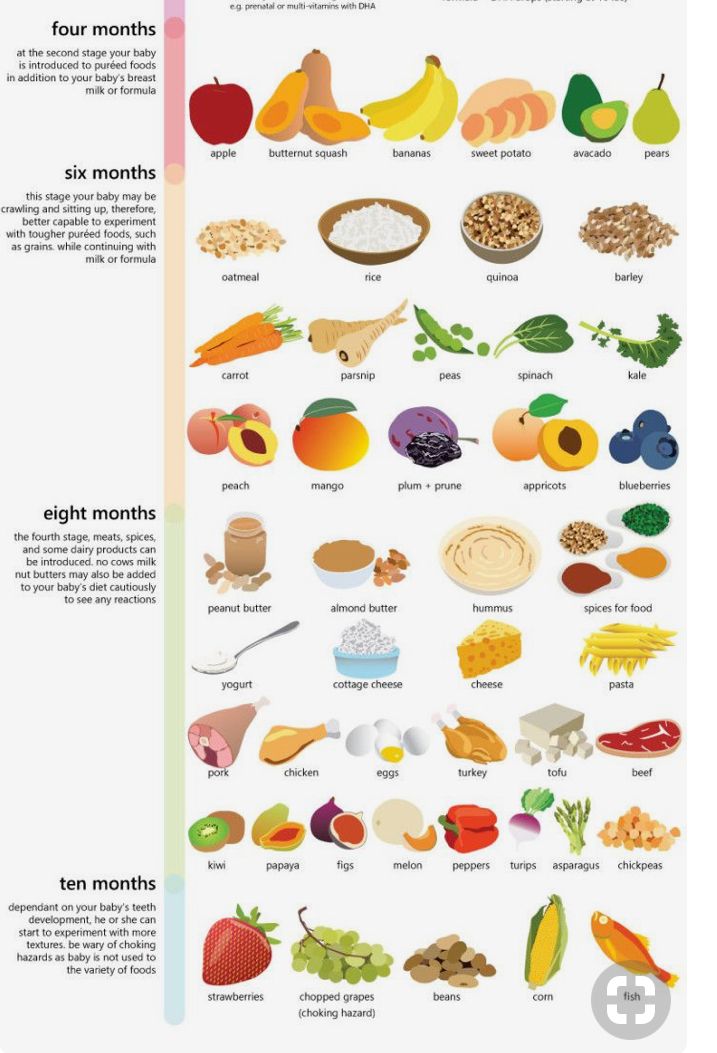
Post Updated on – 11 June 2019, 19 May 2021, 20 March 2022
Post first published on – 7
Make life easier with our eBook, ‘50 First Foods for Babies‘ that has recipes and meal suggestions for every stage of weaning. You can download it for free here.
The information presented here is meant to be a guide and does not replace professional medical advice. You should always discuss your baby’s dietary requirements with your doctor.
Buy Healthy Nutritious Baby, Toddler food made by our own Doctor Mom !
Shop now!Complementary foods at 6 months | Useful tips from the Tyoma brand
Pediatricians around the world, including experts from the World Health Organization, unanimously believe that the introduction of complementary foods should be carried out in the interval of 4-6 months.
Early introduction of complementary foods (up to 4 months).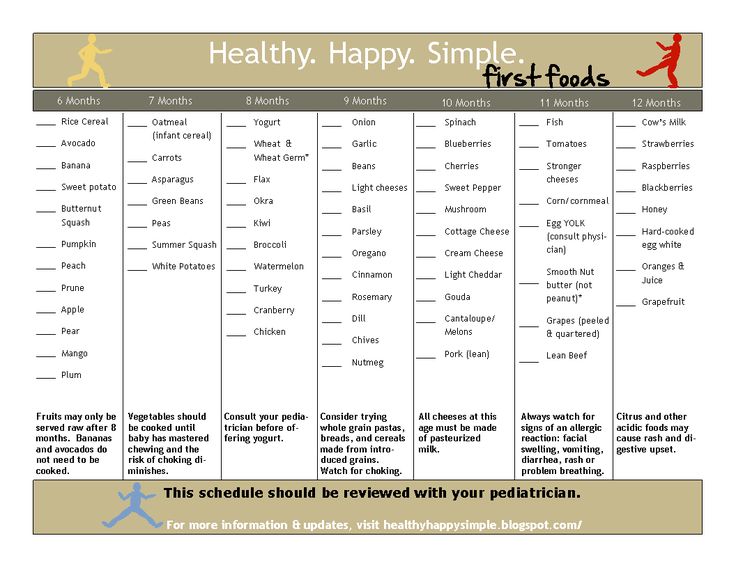 fraught with the development of allergic reactions and indigestion.
fraught with the development of allergic reactions and indigestion.
Late introduction of complementary foods, from 7 months, can lead to a deficiency in the child's nutrition of essential nutrients, an iron deficiency state at the age of 9-10 months, eating disorders, delayed development of chewing skills and swallowing of thick foods.
With the normal development of the child and the absence of signs of iron deficiency anemia, complementary foods can be introduced from 6 months. This applies to both formula-fed and breast-fed babies.
Signs that a baby is ready to breastfeed include
- Absence of the spoon-ejection reflex
- the presence of a bright food interest in the baby to the food of adults
It is important to remember that a child’s lack of teeth and the ability to sit are not signs of a baby’s unpreparedness for eating thick foods.
It is very important to understand the main goals of the introduction of complementary foods:
- Provide the child with the necessary nutrients.

- Develop a child's food interest, introduce him to new tastes.
In no case should the introduction of complementary foods be of a violent nature, since this will not only not contribute to the development of a child’s food interest, but can also lead to a complete refusal of the baby from complementary foods, which will destroy the main goals of complementary foods.
How to start introducing complementary foods at 6 months of age?
The first product of complementary foods, regardless of the start date of the introduction of complementary foods and the type of feeding of the baby (breast or artificial), should be energy-intensive foods: porridge, or vegetable puree.
If the child has a liquefied or unstable stool, and there is also a lack of body weight, then it is better to choose porridge as the first complementary food. After 3-4 days from the beginning of the introduction of porridge, butter can be gradually added to it (up to 5 g per serving of porridge in 150 g)
If the child has a tendency to constipation, then it is better to choose vegetable marrow puree as the first complementary food, which can have a mild laxative effect on the child's stool.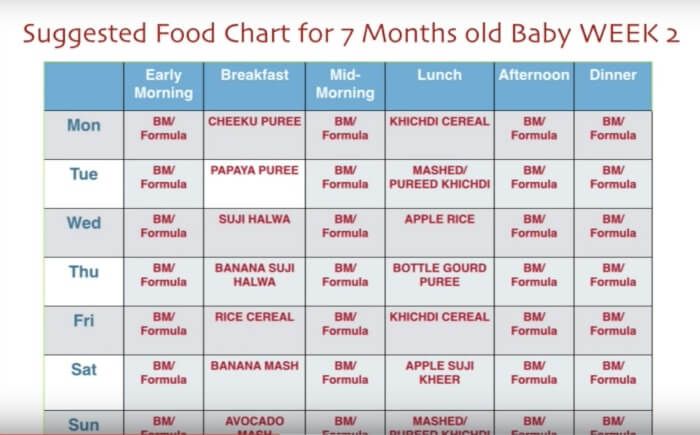 Starting from the 3-4th day of the introduction of vegetable puree, vegetable oil can be gradually added to it (up to 5 g per serving of vegetables in 150 g)
Starting from the 3-4th day of the introduction of vegetable puree, vegetable oil can be gradually added to it (up to 5 g per serving of vegetables in 150 g)
What products are better to give preference to at 6 months?
Kashi
The first cereals can be buckwheat, rice or corn. They must be dairy-free and can be diluted with water or breast milk, or the mixture that the baby eats. Later, you can introduce oatmeal and millet porridge
Vegetables
The first vegetable puree can be zucchini, broccoli, or cauliflower. Later, kohlrabi, potatoes, green beans, white cabbage, green peas, celery can be introduced into the diet.
Fruit
The third type of complementary foods can be fruit puree from apples, pears or bananas. Later, you can introduce mashed apricot, peach. For starters, fruit puree may not be given to the child separately, but it is better to mix it with cereal or vegetables so that the child does not begin to prefer the sweet taste of fruits.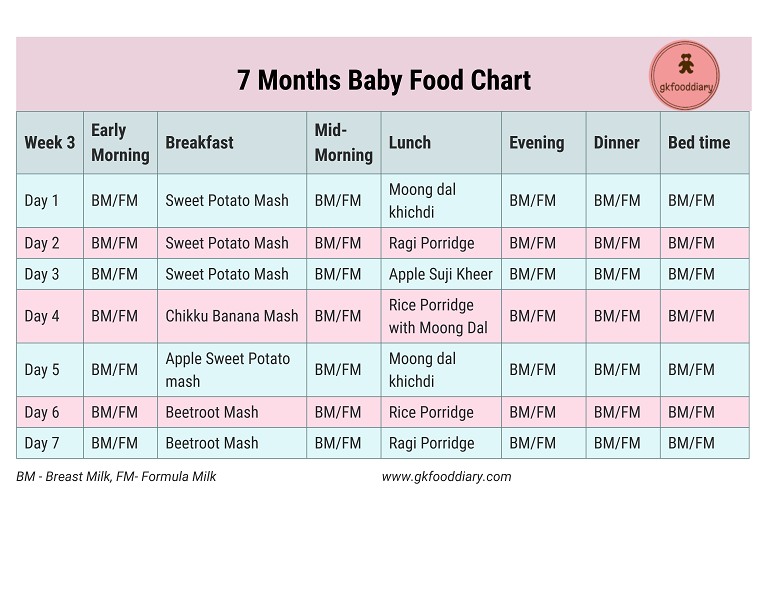 When the amount of fruit puree reaches 50 g or more, it can also be given separately, for example, after the child has eaten porridge or cottage cheese.
When the amount of fruit puree reaches 50 g or more, it can also be given separately, for example, after the child has eaten porridge or cottage cheese.
Juices
Juices should not be the first feeding, in addition, they can not be introduced into the baby's first year of life at all, given their sweet taste and low nutritional value.
Basic rules for the introduction of complementary foods from 6 months
- A faster introduction of the main complementary foods into the child's diet compared to their introduction from 4 or 5 months, namely, bringing the amount of one product to the age volume can be carried out in 5-7 days.
- Introduction of complementary foods before breastfeeding or formula.
- Feeding the child is carried out not at the request of the child, but at the request of the mother. What it means: you should try to introduce complementary foods regularly and at the same time, allocating for this conditionally time for the future breakfast, lunch and dinner (afternoon snack).
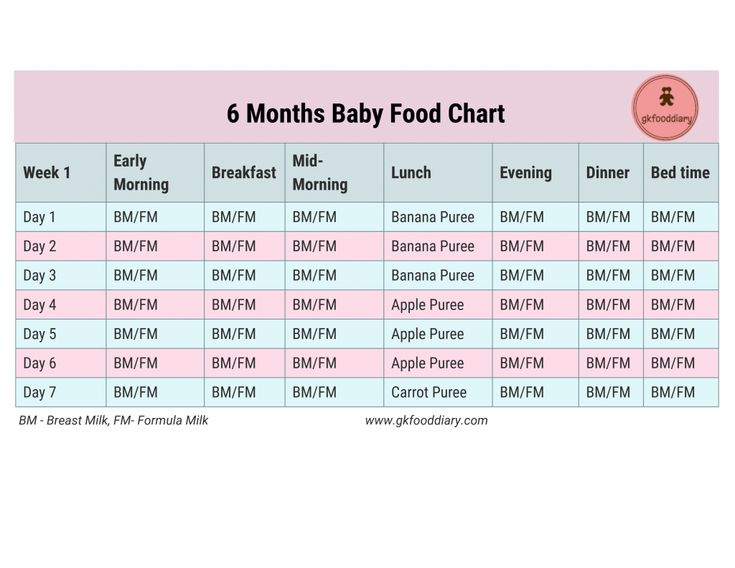
How to start the introduction of a new product?
The introduction of a new product should be gradual.
- On day 2 - 3 tsp. (15 g)
- On day 3 - 6 tsp. (30 g)
- Day 4 - 50 g
- Day 5 - 100 g
- On the 7th day - 150 g
Important!
If on the 5-7th day of the introduction of a new product, the baby still cannot eat 100-150 ml of porridge or puree at once, then this amount can be divided into 2 doses, for example, give 100 ml of porridge in the morning and 50 ml in the evening.
From the second week of the introduction of a new product, one milk feeding can be completely replaced with complementary foods.
Approximate weekly feeding schedule
If we start complementary foods with vegetable puree, then the schedule might look something like this:
- Morning feeding (6:00 am): breast milk or infant formula 180-200 ml
- Breakfast (10:00): breast milk or infant formula 180-200 ml
- Lunch (14:00): broccoli 10-150 grams.
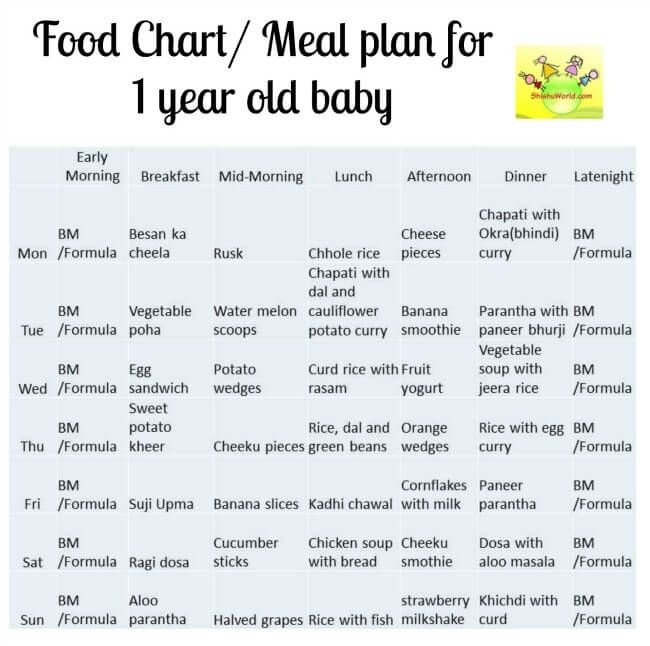 Supplementing with breast milk or infant formula
Supplementing with breast milk or infant formula - Afternoon snack (18:00): breast milk or infant formula 180-200 ml
- Night feeding (22:00): breast milk or infant formula 180-200 ml
2 weeks
From the second week, you need to start introducing dairy-free porridge.
- Morning feeding (6:00 am): breast milk or infant formula 180-200 ml
- Breakfast (10:00): porridge 10-150 g, supplemented with breast milk or infant formula
- Lunch (14:00): Broccoli 150 grams. Vegetable oil 5 g Supplementary feeding with breast milk or infant formula up to 50 ml
- Afternoon snack (18:00): breast milk or infant formula 180-200 ml
- Night feeding (22:00): breast milk or infant formula
3 week
From the third week, you need to start introducing meat puree, which is most convenient to add to vegetable puree
- Morning feeding (6:00 am): breast milk or infant formula 180-200 ml
- Breakfast (10:00): porridge 150 g, supplemented with breast milk or infant formula
- Lunch (14:00): Broccoli 150 grams.
 Vegetable oil 5 g Meat puree 5-20 g Supplementation with breast milk or infant formula up to 50 ml
Vegetable oil 5 g Meat puree 5-20 g Supplementation with breast milk or infant formula up to 50 ml - Afternoon snack (18:00): breast milk or infant formula 180-200 ml
- Night feeding (22:00): breast milk or infant formula
4 week
From the fourth week, you can introduce fruit puree, which is most convenient to add to porridge
- Morning feeding (6:00 am): breast milk or infant formula 180-200 ml
- Breakfast (10:00): porridge 150 g, fruit puree up to 50 g
- Lunch (14:00): Broccoli 150 grams. Vegetable oil 5 g Meat puree 20 g Supplementation with breast milk or infant formula
- Afternoon snack (18:00): breast milk or infant formula 180-200 ml
- Night feeding (22:00): breast milk or infant formula
From the fifth week, you can begin to introduce the second type of porridge, which is most convenient to start adding to the first type, gradually displacing its amount.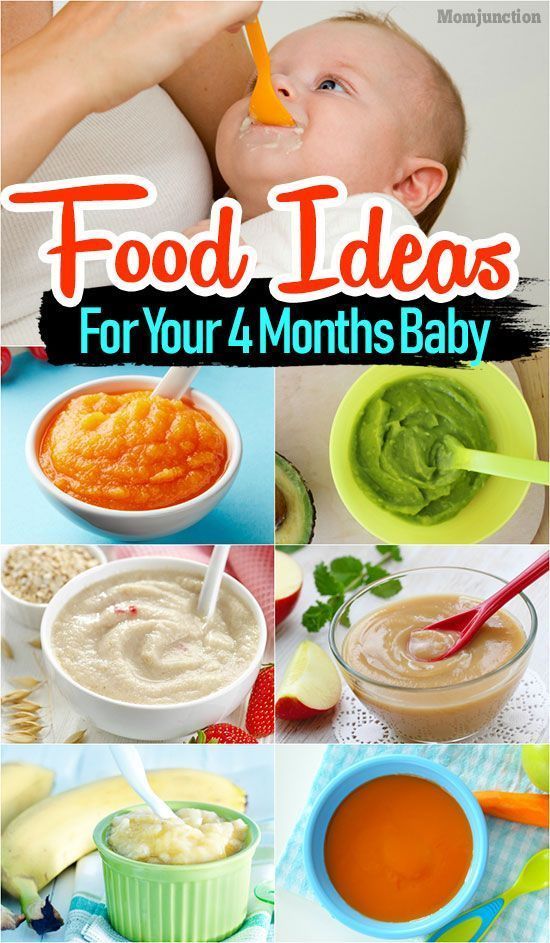
From the sixth week, you can enter another type of vegetable puree. And so on.
By 7 months two milk feedings can be completely replaced with complementary foods.
Diet for a 4-6 month old baby
Your baby is already 4 months old. He has noticeably grown up, become more active, is interested in objects that fall into his field of vision, carefully examines and reaches for them. The emotional reactions of the child have become much richer: he joyfully smiles at all the people whom he often sees more and more often, makes various sounds.
You are still breastfeeding or have had to switch to formula or formula feeding. The child is actively growing, and only with breast milk or infant formula, he can no longer always get all the necessary nutrients. And that means it's time to think about complementary foods.
The optimal time to start its introduction is between 4 and 6 months, regardless of whether the baby is receiving breast milk or formula.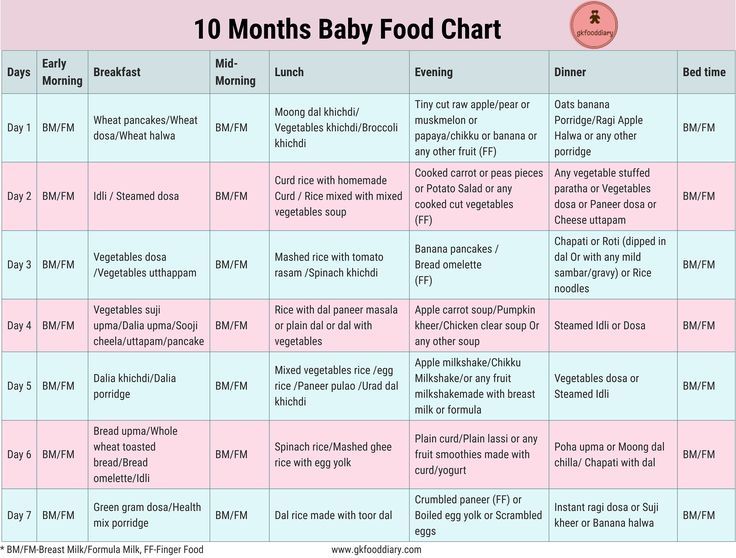 This is the time when children respond best to new foods. Up to 4 months, the child is not yet ready to perceive and digest any other food. And with the late introduction of complementary foods - after 6 months, children already have significant deficiencies of individual nutrients and, first of all, micronutrients (minerals, vitamins, long-chain polyunsaturated fatty acids, etc.). In addition, toddlers at this age often refuse new foods, they have delayed development of chewing skills for thick foods, and inadequate eating habits are formed. It is important to know that, no matter how strange it may seem at first glance, with a delayed appointment of complementary foods, allergic reactions more often occur on them.
This is the time when children respond best to new foods. Up to 4 months, the child is not yet ready to perceive and digest any other food. And with the late introduction of complementary foods - after 6 months, children already have significant deficiencies of individual nutrients and, first of all, micronutrients (minerals, vitamins, long-chain polyunsaturated fatty acids, etc.). In addition, toddlers at this age often refuse new foods, they have delayed development of chewing skills for thick foods, and inadequate eating habits are formed. It is important to know that, no matter how strange it may seem at first glance, with a delayed appointment of complementary foods, allergic reactions more often occur on them.
When is it advisable to introduce complementary foods as early as 4 months, and when can you wait until 5.5 or even 6 months? To resolve this issue, be sure to consult a pediatrician.
As a rule, at an earlier age (4 - 4.5 months), complementary foods are introduced to children at risk of developing iron deficiency anemia, as well as children with insufficient weight gain and with functional digestive disorders.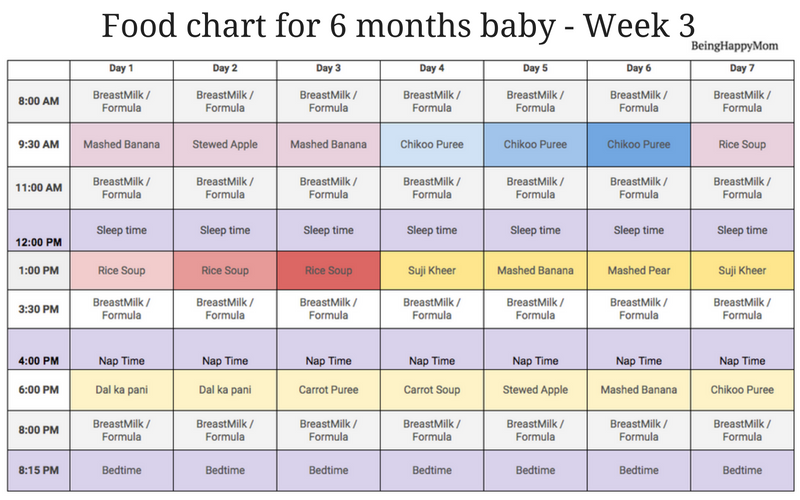
The optimal time to start complementary foods for a healthy baby is between 5 and 5.5 months of age.
The World Health Organization recommends that breastfed babies should be introduced to complementary foods from 6 months of age. From the point of view of domestic pediatricians, which is based on extensive practical experience and scientific research, this is possible only in cases where the child was born on time, without malnutrition (since in these cases the mineral reserves are very small), he is healthy, grows well and develops. In addition, the mother should also be healthy, eat well and use either specialized enriched foods for pregnant and lactating women, or vitamin and mineral complexes in courses. Such restrictions are associated with the depletion of iron stores even in a completely healthy child by 5-5.5 months of age and a significant increase in the risk of anemia in the absence of complementary foods rich or fortified with iron. There are other deficits as well.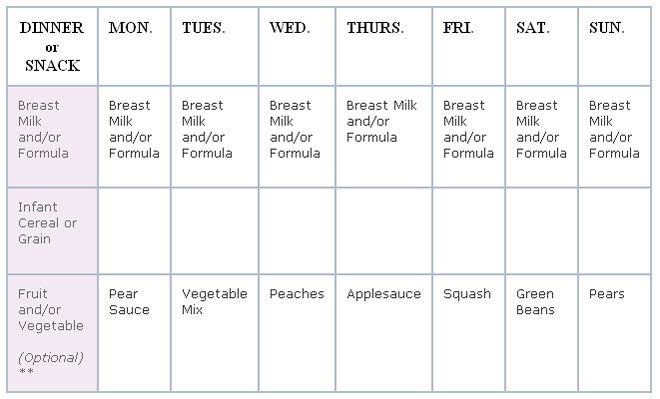
The first complementary food can be vegetable puree or porridge, fruit puree is better to give the baby later - after tasty sweet fruits, children usually eat vegetable puree and cereals worse, often refuse them altogether.
Where is the best place to start? In cases where the child has a tendency to constipation or he puts on weight too quickly, preference should be given to vegetables. With a high probability of developing anemia, unstable stools and small weight gains - from baby cereals enriched with micronutrients. And if you started introducing complementary foods with cereals, then the second product will be vegetables and vice versa.
If the first complementary food is introduced at 6 months, it must be baby porridge enriched with iron and other minerals and vitamins, the intake of which with breast milk is no longer enough.
Another important complementary food product is mashed meat. It contains iron, which is easily absorbed. And adding meat to vegetables improves the absorption of iron from them. It is advisable to introduce meat puree to a child at the age of 6 months. Only the daily use of children's enriched porridge and meat puree can satisfy the needs of babies in iron, zinc and other micronutrients.
It is advisable to introduce meat puree to a child at the age of 6 months. Only the daily use of children's enriched porridge and meat puree can satisfy the needs of babies in iron, zinc and other micronutrients.
But it is better to introduce juices later, when the child already receives the main complementary foods - vegetables, cereals, meat and fruits. After all, complementary foods are needed so that the baby receives all the substances necessary for growth and development, and there are very few in their juices, including vitamins and minerals.
Juices should not be given between feedings, but after the child has eaten porridge or vegetables with meat puree, as well as for an afternoon snack. The habit of drinking juice between meals leads to frequent snacking in the future, a love of sweets is instilled, children have more tooth decay and an increased risk of obesity.
With the start of the introduction of complementary foods, the child is gradually transferred to a 5-time feeding regimen.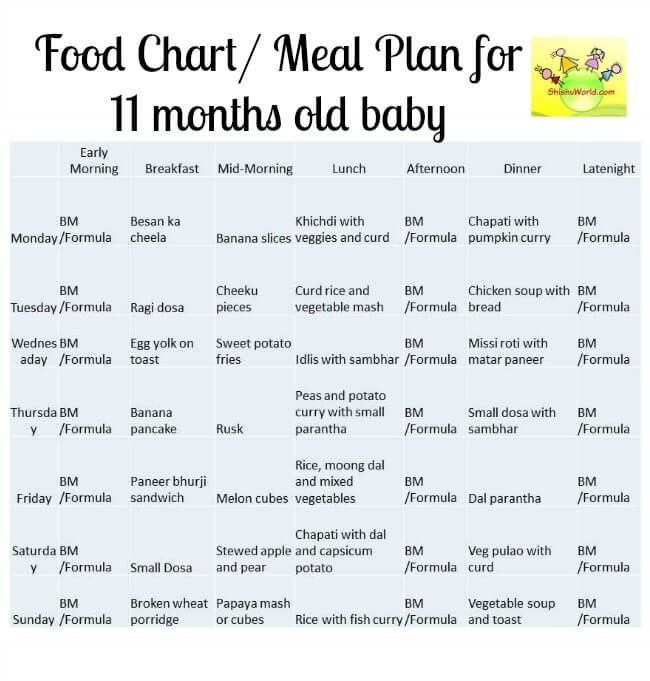
Rules for the introduction of complementary foods:
- Preference should be given to children's products of industrial production, they are made from environmentally friendly raw materials, have a guaranteed composition and degree of grinding
- Complementary foods should be offered to the baby by spoon at the start of feeding, before breastfeeding (formula feeding)
- the volume of the product increases gradually, starting with ½ - 1 spoon, and in 7 - 10 days we bring it to the age norm, subsequent products within the same group (cereals from other cereals or new vegetables)
- can be entered faster, in 5 - 7 days
- start introduction with monocomponent products
- it is undesirable to give a new product in the afternoon, it is important to follow how the child reacts to it
- new products are not introduced in the event of acute illnesses, and before and immediately after prophylactic vaccination (should be abstained for several days)
When introducing a new type of complementary food, first try one product, gradually increasing its amount, and then gradually “dilute” this product with a new one.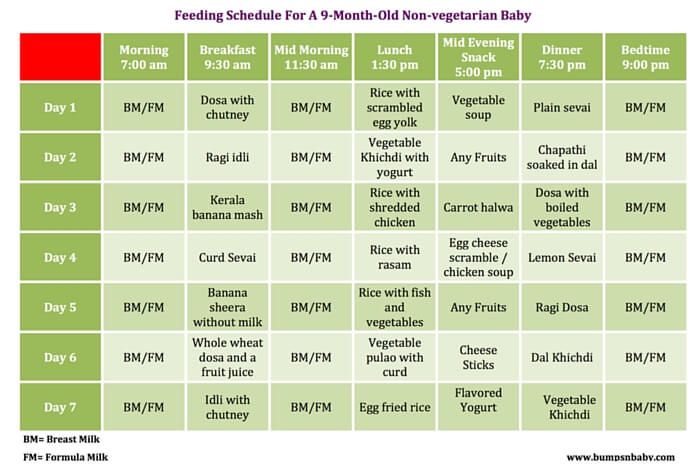 For example, vegetable complementary foods can be started with a teaspoon of zucchini puree. During the week, give the baby only this product, gradually increasing its volume. After a week, add a teaspoon of mashed broccoli or cauliflower to the zucchini puree and continue to increase the total volume every day. Vegetable puree from three types of vegetables will be optimal. The portion should correspond to the age norm. Over time, you can replace the introduced vegetables with others faster.
For example, vegetable complementary foods can be started with a teaspoon of zucchini puree. During the week, give the baby only this product, gradually increasing its volume. After a week, add a teaspoon of mashed broccoli or cauliflower to the zucchini puree and continue to increase the total volume every day. Vegetable puree from three types of vegetables will be optimal. The portion should correspond to the age norm. Over time, you can replace the introduced vegetables with others faster.
After the introduction of one vegetable (bringing its volume to the required amount), you can proceed to the intake of porridge, and diversify the vegetable diet later.
If the child did not like the dish, for example, broccoli, do not give up and continue to offer this vegetable in a small amount - 1-2 spoons daily, you can not even once, but 2-3 times before meals, and after 7 - 10, and sometimes 15 days, the baby will get used to the new taste. This diversifies the diet, will help to form the right taste habits in the baby.
Spoon-feeding should be done with patience and care. Forced feeding is unacceptable!
In the diet of healthy children, porridge is usually introduced after vegetables (with the exception of healthy breastfed children, when complementary foods are introduced from 6 months). It is better to start with dairy-free gluten-free cereals - buckwheat, corn, rice. At the same time, it is important to use porridge for baby food of industrial production, which contains a complex of vitamins and minerals. In addition, it is already ready for use, you just need to dilute it with breast milk or the mixture that the baby receives.
Children suffering from food allergies are introduced complementary foods at 5-5.5 months. The rules for the introduction of products are the same as for healthy children, in all cases it is introduced slowly and begins with hypoallergenic products. Be sure to take into account individual tolerance. The difference is only in the correction of the diet, taking into account the identified allergens.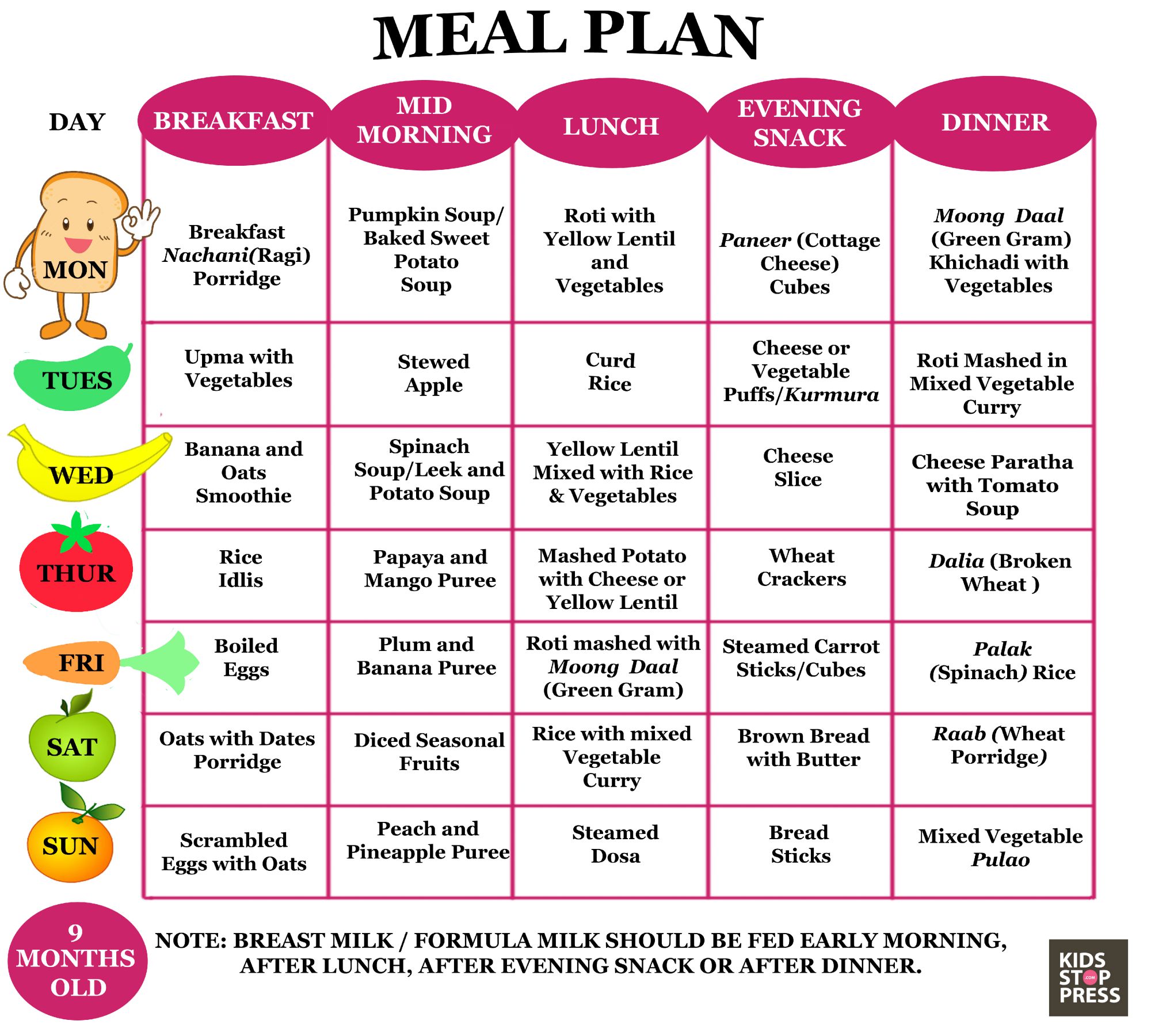 From meat products, preference should first be given to mashed turkey and rabbit.
From meat products, preference should first be given to mashed turkey and rabbit.
Diets for different age periods
Explain how you can make a diet, it is better to use a few examples that will help you navigate in compiling a menu specifically for your child.
From 5 months, the volume of one feeding is on average 200 ml.
Option 1.
If your baby started receiving complementary foods from 4-5 months, then at 6 months his diet should look like this:
| Breast milk or VHI* | 200 ml | |
| II feeding 10 hours | Dairy-free porridge** Supplementation with breast milk or VHI* | 150 g 50 ml |
| III feeding 14 hours | Vegetable puree Meat puree Vegetable oil Supplementing with breast milk or VHI* | 150 g 5 - 30 g 1 tsp 30 ml |
| IV feeding 18 hours | Fruit puree Breast milk or VHI* | 60 g 140 ml |
| V feeding 22 hours | Breast milk or VHI* | 200 ml |
* - infant formula
** - diluted with breast milk or VHI
Option 2.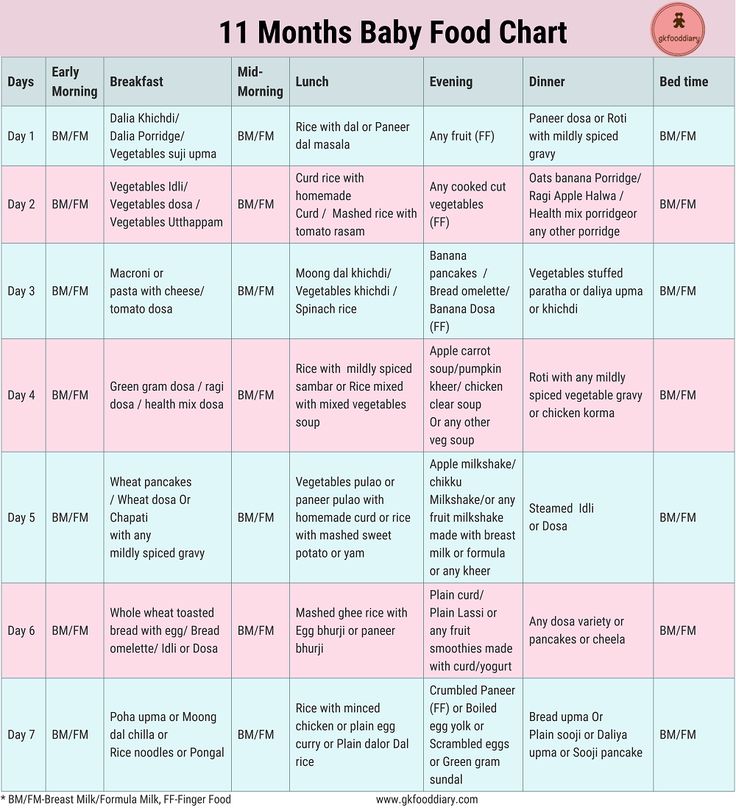
* - infant formula Option 3. : ** - diluted with breast milk Up to 7 months, increase the volume of porridge and vegetable puree to 150 g and introduce fruit puree. I feeding
6 hours Breast milk or VHI* 200 ml II feeding
10 hours Dairy-free porridge**
Fruit puree 150 g
20 g III feeding
14 hours Vegetable puree
Meat puree Vegetable oil
Fruit juice 150 g
5 - 30 g
1 tsp
60 ml IV feeding
18 hours Fruit puree
Breast milk or VHI* 40 g
140 ml V feeding
22 hours Breast milk or VHI* 200 ml
** - diluted with breast milk or VMS 
I feeding
6 hours Breast milk II feeding
10 hours Dairy-free porridge**
Breast milk supplement 100 g III feeding
14 hours Vegetable puree
Meat puree Vegetable oil
Breast milk supplement 100 g
5 - 30 g
1 tsp IV feeding
18 hours Breast milk V feeding
22 hours Breast milk 